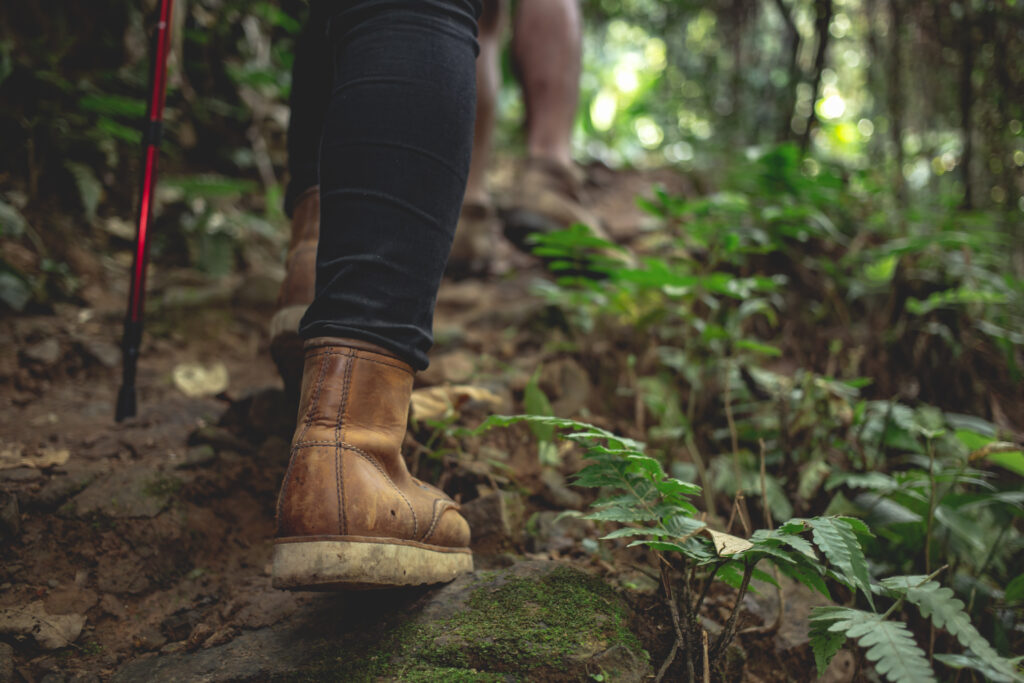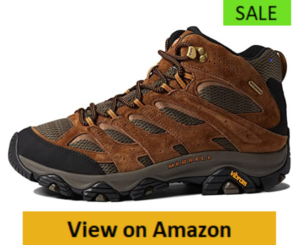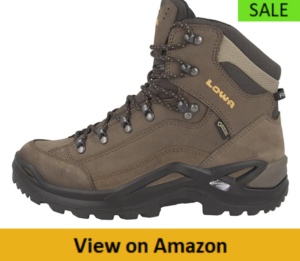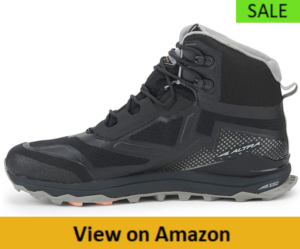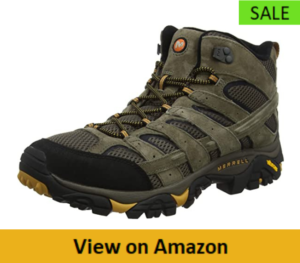Are you looking for the best hiking boots for firm traction on the grinchy field of the mountain? If yes, look no further. In this article, we’ll unveil the best hiking boots that will help you to get strong resistance against the rough and tough surface of the mountains. Before digging into the details, let’s unveil the top reasons why using the best hiking boots is crucial :
1. Foot protection
Good quality hiking boots that provide protection for your feet against rocks, roots, and other hazards you may encounter on the trail.
2. Comfort
Hiking boots that fit well and provide proper support and cushioning can help prevent foot fatigue, blisters, and other foot-related injuries during long hikes.
3. Traction
Hiking boots with sturdy soles and good traction can help prevent slips and falls on uneven or slippery terrain.
4. Support
Good hiking boots provide support for your feet and ankles, reducing the risk of sprains or other injuries. Moreover, it will help you maintain balance during steep ascents or descents.
5. Waterproofing
In wet conditions, waterproof hiking boots can help keep your feet dry, reducing the risk of blisters and other foot-related injuries.
6. Breathability
Breathable hiking boots help keep your feet dry and reduce the risk of overheating, which can lead to blisters and other foot-related injuries.
7. Durability
High-quality hiking boots are designed to last, so you can enjoy many miles on the trail without worrying about the boot wearing out.
As a result, using the best hiking boots is crucial to ensure a safe and comfortable hike, reducing the risk of foot-related injuries and allowing you to focus on the beauty of the trail. It is crucial to choose the best boots for your needs taking into consideration factors such as the type of hiking you will be doing, the conditions you will be hiking in, and your own personal preferences.
Merrell Men’s Moab 3 Mid-Hiking Boots
According to experts like Rasmussen, the Moab 3’s comfort extends from the first step to kilometers of the slope, which is a significant game-changer. For an affordable price, it provides safety and support for treks and short backpacking trips. Due to its mesh ventilation, this boot works well in warm weather, but since it is not waterproof, it is not the best choice for damp or marshy circumstances. These are cozy right out of the box thanks to the cushioned but flexible collar, the thick tongue, and the shock-absorbing air cushion in the heel. Furthermore, the Moab 3 is a better option for someone with broad feet because they seem wider than other shoes on our list.
The Moab 3 has a 5 out of 5 rating for blister prevention since the upper and midsole don’t rub against each other even when you step off the path. A solid rubber toe cap serves as protection for your toes, and they will last for numerous climbs. Overall the sole has 5-millimeter-deep lugs that deliver reliable traction, while the midsole’s molded arch adds stability.
Pros
- Offers firm traction and a solid grip along the ground
- Has a stable rubber toe cap
- Best hiking shoes for the wider foot
- Supportive and stable product
Cons
- Not water-resistant
Lowa Men’s Renegade GTX Mid-Hiking Boots
Lowa’s Renegade GTX is a supportive boot designed for hiking challenging terrain that will keep you warm and dry as you journey uncharted territory. In addition, the thin, water-repellent leather upper tested well while being slightly insulated. Even though they are costly, these boots are made to handle any situation, so no matter where you go off-road, you only need one pair.
The gusseted tongue and GORE-TEX lining kept our tester’s feet completely dry even while submerged, earning a 5 out of 5 rating for water resistance. Back on the path, we were impressed by how the perforated footbed of these boots allowed heat and sweating to be dissipated, making them a fantastic option for prolonged excursions.
The midsole is firmer than others on the list, and the robust outsoles might feel hefty. But because of this, the Renegade GTX is stable and supportive enough to withstand dirt, snow, and pebbles, receiving a 5 out of 5 rating for traction. We adore the fact that they have speed hook lacing for an instant and precise fit. The boots come in three dimensions even though our tester said they run a little narrow.
Pros
- Offers a breathable upper material
- Durable and stable product
- Offers a firm grip
Cons
- A bit costly but well worth the price
Altra Lone Peak ALL-WTHR Mid-Hiking Boots
The contemporary Lone Peak ALL-WTHR hiking footwear from Altra is a waterproof boot that is extremely light and cozy for quick day treks. The zero-drop base and responsive midsole received a stability and support rating of 4 out of 5. These shoes are perfect for people with broader feet since the toe box during testing allowed our testers’ toes to relax and spread out.
However, because the upper is waterproof, some hikers who prefer a more flexible, lightweight boot may find the fabric excessively stiff. Due to the wide-spaced lugs, the gripping outsole performs well on soft, sloppy, and snowy paths, earning these boots a 5 out of 5 for traction. When fastened, the inside weatherproof fabric molded to the foot and ankle while keeping feet incredibly dry on the walk.
These lightweight boots, which only weighed a little under 2 pounds, were “like wearing a hiking sock with a rubber sole.” While we appreciate the mid-height, flexible ankle collar, and plush midsole, they can be problematic for lengthy, strenuous journeys.
Pros
- Offers a wide-toe box
- Breathable and water-resistant upper material
- Firm and stable traction
- Trendy and sleek design
Cons
- Not an ideal option for heavy-duty hiking
Columbia Men’s Bugaboot III Snow Boots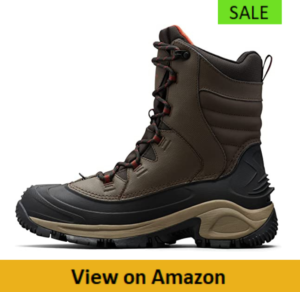
Our top option for a hiking boot with sufficient insulation and traction to perform well in cold climates is Columbia’s Bugaboot III. They include complete waterproofing, seam-sealed lining, and thermal insulation for versatile, multi-terrain winter performance. This boot received a perfect score of 5 out of 5 for waterproofing during testing due to its cushioned, plush collar, gusseted tongue, and tall profile which kept snow and water out.
Moreover, these boots may run small and narrow, therefore we advise sizing up, especially if you intend to wear thick socks. The Buggaboot has a multi-directional sole that will keep you on your feet and a removable, cushioned foot-bed that cushions impact. For maximum traction, protective rubber climbs up the strengthened toe and up the back into a heel brake. In addition to the traction and stability, this pair received a perfect score of 5 out of 5 from our tester, who also mentioned that the boots won’t leave a trace on the floor when you return inside from the cold.
Furthermore, They are lighter than the majority of the other boots on our list as well. Other distinguishing characteristics include a lace-up fastening that stays tightly secured. However, because these boots don’t have a rapid lacing mechanism, it could be difficult to lace them while wearing gloves.
Pros
- Dependable and durable product
- Lightweight and waterproof
- Provide thermal insulation
- Offers lace-up closure system
Cons
- While wearing gloves, it might be hard to adjust
KEEN Women’s Targhee 3 Mid-Height Waterproof Hiking Boots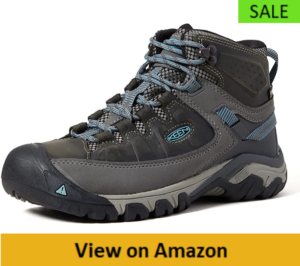
We suggest Keen’s Targhee III, a roomy and sturdy boot with space for feet to expand out for maximum comfort, for hikers who require more room in their foot-beds. Additionally, the composition of the midsole, outer, and upper materials makes this boot both flexible and robust, with the comfort of a daily shoe. While the lacing system has a strap that is wrapped around the heel for a unique fit, ample ankle padding gentle supports.
However, this boot lacks the padding that hikers with large packs frequently require as a trade-off for such collar comfort and flexibility. Our tester gave this boot a 4 out of 5 for support and cushioning, deeming it better suited for daily walks.Nevertheless, we believe that the 4-millimeter lugged traction, toe and mudguards, and leather top will provide enough durability for numerous day treks in the future. Additionally, in warm weather, the odor control system will keep your feet dry and fresh.
Pros
- Lightweight and waterproof
- Offers a height that hit above the ankle
- Offers speed hook lace system
- Provide firm traction along the track
Cons
- Not suitable for the long hikes
- No thermal insulation
La Sportiva Mens Ultra Raptor II Mid GTX Hiking Boots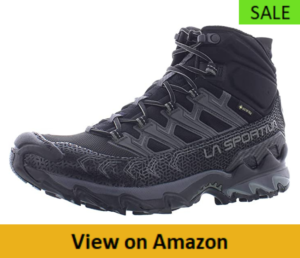
We advise La Sportiva’s Ultra Raptor II boot for people with narrow feet. This boot is flexible and lightweight and provides enough protection for different terrain while trekking. On test hikes, these pair are molded, cushioned midsoles scored a 4 out of 5 rating for comfort and a 4.5 out of 5 rating for stability. The Ultra Raptor is a flexible shoe that is less supportive than others on our list, but it also incorporates ankle mudguards to keep debris out.
We adore how these boots’ sticky rubber outsoles provide excellent traction on slippery, uneven terrain. The midsole and heel felt well-bolstered during testing, with adequate shock absorption on different types of terrain, according to our hiker. An integrated gaiter with a handy pull tab for putting on and taking off the boots is fitted into the ankle collar. Our tester discovered that the lining and upper mesh allowed air to enter while preventing moisture from escaping, keeping his feet dry on a trip through fresh streams, dirt, and a waterfall.
Pros
- Offers an excellent traction
- Waterproof
- The minimal period of break-in
Cons
- Not well insulated
Salomon Men’s X Ultra 4 Mid Gore-tex Hiking Boots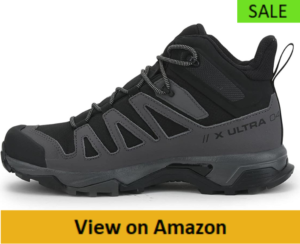
We suggest these Salomon boots if you’re searching for trail boots that are lightweight and versatile enough to take you from a day trip to a long plane journey. The lugs on the X Ultra 4’s stability and traction make it ideal for climbing steep inclines. Additionally, it is GORE-TEX lined for waterproofing. While mudguards and rubber toe caps guard against hazards like rocks and tree roots, tongue gussets keep irritating debris out.
The flaw with ironclad water defense? It received a 4 out of 5 for blister protection because it didn’t breathe as well as some alternatives and caused some hot patches. Even on lengthy hikes, the Ultra 4’s comfort and support are quite impressive. This trail-runner boot hybrid’s stability is further increased with a lacing strap chassis that snugly fits the foot. We enjoy how this boot can handle a demanding day and offers a roomy toe box and heel stability. It might not provide enough support for hikers carrying large packs, though.
Pros
- Provides a tight hug fit around the feet
- Offers a firm ankle support
- Durable and lightweight
Cons
- Not suitable for large packs
Merrell Men’s Moab 2 Vent Mid-Hiking Boots
In this Merrell footwear with good ventilation, you can stay dry and cool while the temperature rises. Mesh lining on the Moab 2 Vent breathes and swiftly drains sweat to eliminate odors. The sturdy midsole and contoured arch of this shoe helped our tester’s feet feel less worn out.
Although the ankle is well padded, some hikers might find the supporting heel to be excessively high. Thanks to its 5-millimeter lug sole, this shoe has excellent traction. Our hiker gave it a good review, calling the sole a “complete beast,” and gave it a rating of 5 out of 5 for traction. We adore the Moab 2 Vent boot for its performance and affordability right out of the box. It is lightweight and comfy. Just keep in mind that it’s not totally waterproof despite being water-resistant.
Pros
- Breathable and pocket friendly
- Long-lasting
- Extra padding to enhance the cushion
Cons
- Not waterproof
Pro Tips to Buy Best Hiking Boots
Here are some tips to keep in mind while buying best hiking boots.
Firm Traction
To maintain traction on loose, muddy, slippery, or steep terrain, hiking boots with the appropriate traction are crucial. When choosing the best tread for your needs, it’s prime to consider the type of terrain you’ll be traveling on frequently. The outsoles of hiking boots are often made of tough, gripping rubber with 4-millimeter or larger lugs, which resemble the cleat-like traction found on many sporting shoes.
While a softer rubber sticks better to rougher surfaces like wet rock but might wear out more quickly over time, a sturdy rubber can be preferable for softer terrains like mud or snow. The most suitable rubber is typically the medium-sticky rubber found in Vibram soles. While going downhill, the best hiking shoes could also have an enlarged back heel for extra control.
Protection and Stability
Materials are crucial for keeping you dry and warm or cold. It is important to protect your feet whether you’re crossing a foot-soaking ford or a rock-hop trickling brook. Waterproof boots typically have GORE-TEX linings, membranes, or comparable technology and will keep your feet dry, warm, and free of blisters. Water-resistant often refers to a surface treatment that deters moisture but does not necessarily shut it out. Remember that waterproof boots occasionally tend to weigh more, be less breathable, and even cost more than other boots.
When planning your excursion, keep in mind additional safety elements like insulation for cold weather or unique lacing methods like quick-lace hooks or drawstring lock laces, which are beneficial if you’re trying to lace boots while wearing gloves. To protect your feet some boots additionally have sole or toe protection features like footplates, lighter, stiffer nylon shanks, and steel or reinforced rubber toes.
Comfort
Your new boots shouldn’t make hiking difficult. Choose a pair that offers adequate cushioning for the best fit. After being laced up, your boots should feel excellent, with no uncomfortable pressure points or friction around the ankle collar. To prevent your foot from slipping the heel box should grasp the back of your foot. Based on the shape of your foot and arch, the upper and midsole should be both cozy and supportive. Additionally, the toe box should have enough space for your foot to easily expand out while hiking.
Support
You’ll need enough support to keep you on your feet while you travel over uneven hills and rocky land. First, think about how much your boots weigh. You can choose how heavy your shoes should be by considering the terrain and the amount of your bag. Next, consider the ankle support, which is a result of the boot’s height. According to Rasmussen, “as a general rule, the harder the path and heavier the pack, the more ankle support your footwear should provide.”
Bulky boots with sturdy, thick soles and cushioning are typically needed for strenuous hikes with heavy packs. For day treks on easier terrain, a thinner sole is good because it reduces speed, energy, and the possibility of the knee and hip flexor stress.
FAQs:
Are Salomon the best hiking boots?
Salomon is a well-known brand in the outdoor gear industry and their hiking boots are known for their quality, durability, and performance. However, it’s subjective to say whether they are the “best” as different people have different preferences and requirements for hiking boots. It’s best to try on different brands and models of hiking boots to find the one that fits you the best and suits your needs.
Are Adidas Terrex good for hiking?
Adidas Terrex is a line of outdoor footwear and apparel that is designed for various outdoor activities including hiking. Their hiking boots are lightweight, breathable, and comfortable to wear, making them suitable for hiking. However, whether they are good for hiking or not will depend on individual preferences, needs, and the specific conditions of the hike.
What are 3 season hiking boots?
Three-season hiking boots are designed to be used in spring, summer, and fall. They are typically made of lightweight and breathable materials, which make them suitable for warm to mild weather conditions. They usually provide good traction and support on uneven terrain but may not be suitable for harsh winter conditions.
How heavy should hiking boots be?
The weight of hiking boots can vary depending on the materials and features they have. Generally, hiking boots should not be too heavy, as this can cause fatigue and make the hike more difficult. A good range for hiking boots is between 1.5 to 3 pounds per pair, but this can vary depending on the type of hiking you plan to do and your personal preferences.
What is the difference between hiking shoes and hiking boots?
The main difference between hiking shoes and hiking boots is the ankle support they provide. Hiking boots typically have higher ankle collars that provide more support and protection to the ankles, while hiking shoes have lower ankle collars that offer more freedom of movement. Hiking shoes are typically lighter and more breathable than hiking boots, which make them suitable for less rugged terrain and warmer weather.
Are heavier boots better?
The weight of hiking boots is a matter of personal preference and depends on the type of hiking you plan to do. Heavier boots may provide more support and protection to the feet and ankles, which can be beneficial for rugged terrain and heavy loads. However, they can also cause fatigue and make the hike more difficult. Lighter boots may be more comfortable and suitable for less rugged terrain and shorter hikes. It’s best to try on different boots and find the one that fits and feels comfortable for your specific needs.
Final Thoughts
After going through this review guide, we hope you are well-versed in the best hiking boots to make your hiking experience more unforgettable. So, we recommend you try the best hiking boots from Amazon. Before buying a pair for your hiking, let’s take a deep look at the pro tips and guides by our experts to find the best hiking boots.
